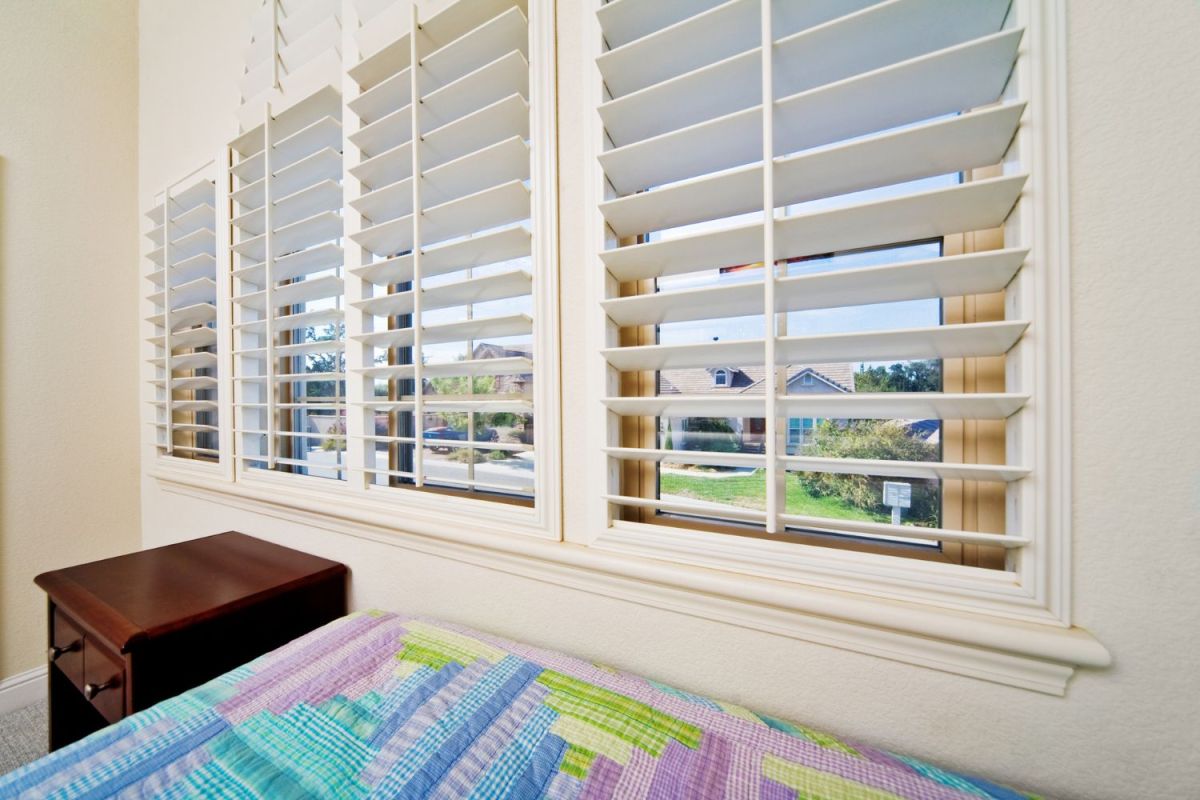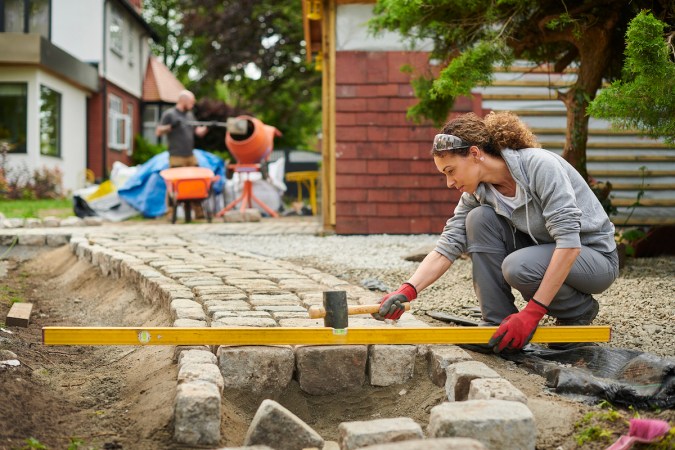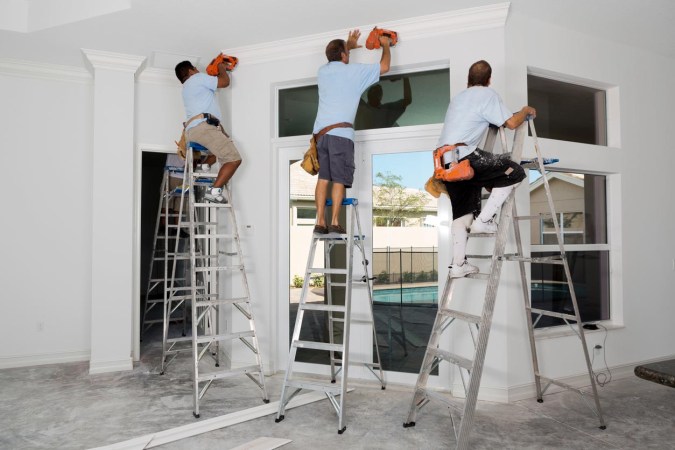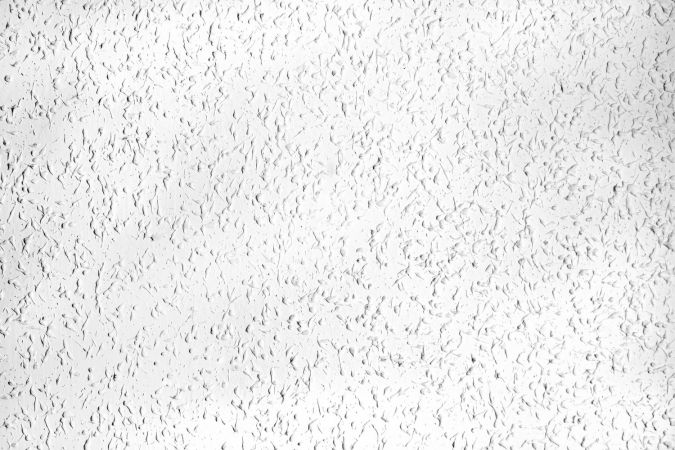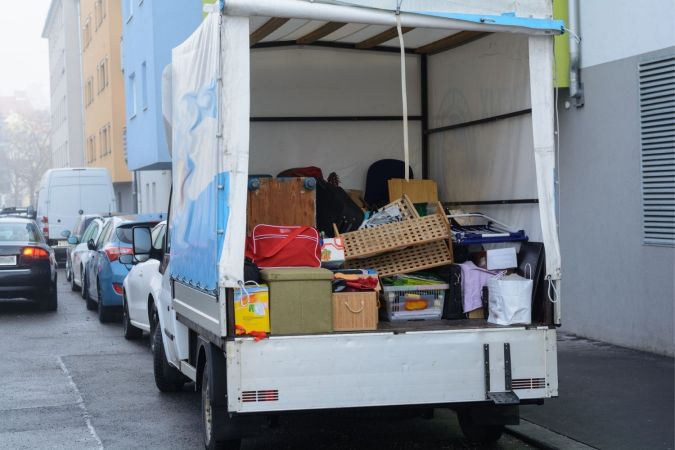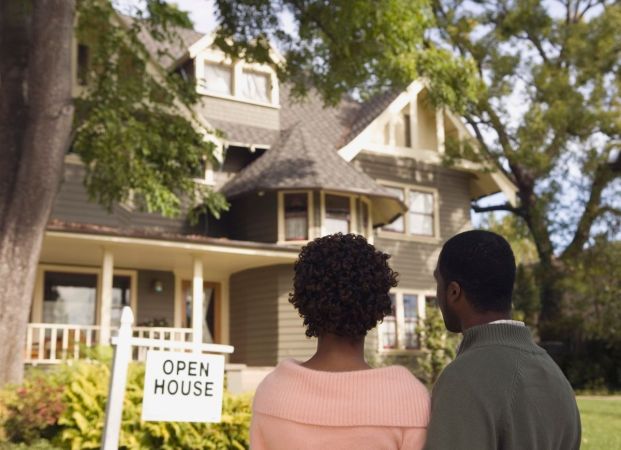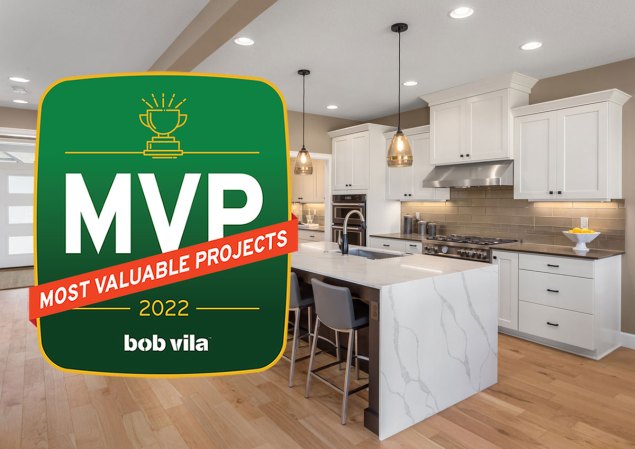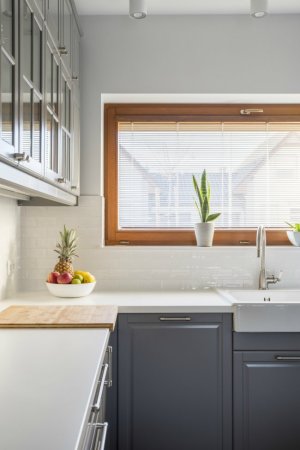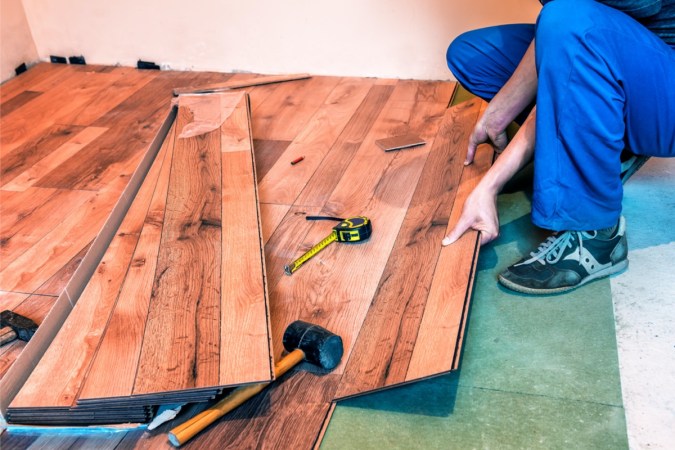We may earn revenue from the products available on this page and participate in affiliate programs. Learn More ›
- Typical Range: $1,295 to $4,549
- National Average: $2,803
This article contains the outdated term “plantation shutters,” a widely recognized description for a particular style of window covering. We acknowledge the problematic nature of the term and have mostly used the alternate phrase “estate shutters.” However, for purposes of explanation, the term “plantation shutters” is used throughout the article.
Plantation shutters, also known as estate shutters, are louvered indoor window treatments that block the sun and heat while still allowing for ample airflow and light. While these types of window shutters are typically more expensive than other styles of window treatments, they have a very good return on investment (ROI) of about 75 percent. Unlike hurricane shutters or farmhouse shutters, which are installed on the exterior of a home, estate shutters are interior shutters fixed in place on the inside of each window.
According to Angi and HomeAdvisor, plantation shutters cost from $1,295 to $4,549, with the national average at $2,803. Estate shutters typically run from $20 to $45 per square foot, depending on the size and number of windows and the shutter material. The average price to install estate shutters ranges from $45 to $420 per window. The final cost depends on the material, with real hardwood, faux wood, vinyl, and PVC the most common choices. Labor to install indoor shutters runs from $65 to $100 per hour, with many window shutter installations requiring 2 hours per window. Despite the high installation cost, many homeowners choose estate shutters instead of traditional blinds due to their energy-efficiency, increased insulation from both cold and heat, and longevity. Below are important factors that affect estate shutter costs, common estate shutter materials, the benefits of installing estate shutters, and some frequently asked questions regarding window shutter installation. A reputable window treatment professional can answer any questions about shutters for house exteriors.
The History of Plantation Shutters
Although they originated in ancient Greece, estate shutters are associated with the American South during the time of slavery (thus the original name, “plantation shutters”). They were originally made from marble or other natural stone to provide privacy and to control airflow and light. When these types of shutters for windows grew in popularity, artisans began making them from wood, since it was a more affordable and readily available material than marble. This style of wooden shutters eventually made its way across Europe, and they became favored in France and Spain. The Spanish colonizers brought estate shutters to the American South, where they became a fixture in large plantation houses, hence the original name. Although the shutters were originally installed on the exterior of a home, they’re now used on the interior of the windows to control temperature and airflow changes inside the home. Estate shutters are still popular today because they’re easy to clean, sturdy, energy efficient, and safe for children and pets.
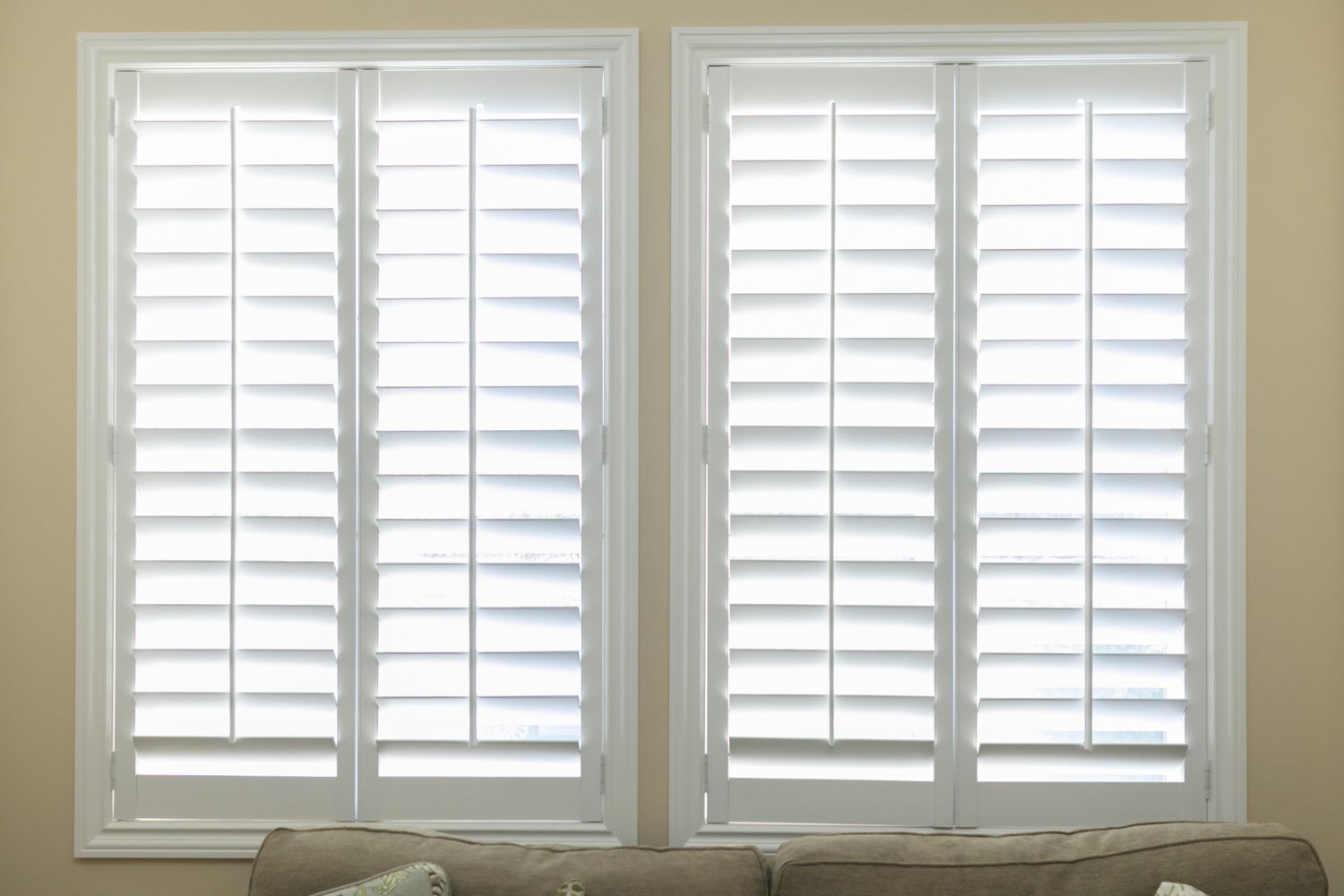
Factors in Calculating Estate Shutters Cost
There are several factors that go into calculating estate shutters cost. Prices to install estate shutters can vary from the national average due to shutter material, window size, number of shutters, local labor rates, installation location, and geographic location.
Shutter Material
The pricing of estate shutters depends on the shutter material. Material pricing for a home with eight windows averages between $360 and $3,360. Real hardwood is the most expensive option, ranging from $55 to $420 per shutter, and a faux wood shutter costs from $45 to $300. Other material options are vinyl and PVC, which both run from $100 to $300 per shutter. The individual shutter material options are discussed below.
Window Size
The bigger the window, the more expensive the cost to install estate shutters. The average cost per square foot ranges from $20 to $45, with many window professionals offering discounts for bulk or wholesale orders. Real hardwood estate shutters for a 42-inch by 48-inch window cost $516, and faux wood shutters for a 16-inch by 20-inch window costs about $39. Window professionals may also charge more for installing estate shutters on larger windows than smaller ones. Below is the difference in pricing for various window sizes and estate shutter materials.
| Window Size | Hardwood | Faux Wood | Vinyl |
| 16-inch by 20-inch | $177 | $39 | $73 |
| 24-inch by 50-inch | $300 | $145 | $200 |
| 36-inch by 54-inch | $497 | $235 | $305 |
| 36-inch by 60-inch | $552 | $261 | $336 |
| 42-inch by 48-inch | $516 | $243 | $315 |
| 48-inch by 44-inch | $540 | $255 | $327 |
Number of Shutters
The more estate shutters that are needed, the more expensive the installation project. To install estate shutters in an entire home, the price can range from $1,295 to $4,549, with the national average at $2,848. The type of window also affects the price of estate shutter installation. Below are a few types of windows and doors that can drive up the total project price of an estate shutter installation project.
- Bay window estate shutters. Installing estate shutters over bay windows can cost about $800 to cover the center window pane ($270 for faux wood and $350 for hardwood) and the side window panes ($150 each for faux wood and $200 each for hardwood).
- Sliding glass door estate shutters. For an 80-inch by 60-inch sliding glass door, homeowners can expect to pay around $860 to install estate shutters. For a larger 80-inch by 72-inch sliding glass door, the installation price increases to approximately $1,040.
- French patio door estate shutters. An 80-inch by 24-inch French patio door will cost about $640 for estate shutter installation, and the price will increase to approximately $950 for an 80-inch by 36-inch French patio door.
- California shutters. Some homeowners prefer the look of California shutters’ smaller 1- to 2-inch louvers. The cost of these shutters ranges from $1,400 to $3,400, with many homeowners spending $2,200, or $20 to $45 per square foot including labor.
Labor
Along with the average rate of $20 to $45 per square foot for materials, window contractors can charge from $65 to $100 per hour for labor. The total amount can vary from location to location, since labor rates are usually more expensive in densely populated urban areas than in more rural areas. It usually takes 2 hours to install each estate shutter, but that can change depending on the level of difficulty for each window.
Installation Location
Depending on the age of the home, windows in certain locations of the house may be unusually shaped and require custom-made shutters. Another factor that dictates whether estate shutters can be installed is the type of window. For example, estate shutters do not work on windows that tilt to open.
Geographic Location
Estate shutter installation costs can differ based on geographic location. Certain types of materials may be more expensive and less common in some areas, and they may be more affordable and accessible in others. For example, homeowners in Mobile, Alabama, will pay between $1,695 and $2,245 to install estate shutters, while those in New York City will pay closer to $1,720 to $3,580. Discussing estate shutter installation with a local window professional can help homeowners get an idea of labor and material costs within their area.
Types of Estate Shutters
There are four types of material used to make estate shutters: hardwood, faux wood, vinyl, and PVC. The most budget-friendly options are vinyl and PVC, which are light and easy to install. Hardwood estate shutters are considered a more traditional material and are the most expensive option, with faux wood options offering a close look-alike at a lower cost.
Hardwood
For a number of years, estate shutters were made only from basswood, a hardwood that has a subtle grain and fine texture. This lightweight material is suitable for staining or painting and is considered the benchmark for estate shutters. While it’s the most expensive option, hardwood will last for many years. For contemporary usage, hardwood estate shutters are commonly installed in bedrooms and living rooms, which generally have low moisture levels. The cost of hardwood estate shutters ranges from $55 to $420 each, depending on size.
Faux Wood
Faux wood, also known as engineered or composite wood, is a budget-friendly alternative to hardwood. Costing between $45 and $300 each depending on size, faux wood estate shutters are wrapped in a hard finish that makes them durable and resistant to humidity, mold, and mildew. Therefore, they are more commonly used in high-moisture areas such as bathrooms. Homeowners should keep in mind that these shutters are not all suitable for painting and are available in a limited range of colors.
Vinyl
Vinyl estate shutters are low maintenance and easy to clean. For homeowners who like the look of estate shutters but want to save on installation costs, opting for a material like vinyl is a budget-friendly choice, as they range from $100 to $300 each.
- Hollow vinyl estate shutters. Hollow vinyl shutters are most commonly used to cover small windows. Since the structure is hollow, it cannot support the weight of a larger frame and will sag over time.
- Structured vinyl estate shutters. Structured vinyl shutters are made with a vinyl support that runs through the shutter frame. They’re sturdier and more expensive than the hollow vinyl option.
- Solid vinyl estate shutters. Solid vinyl shutters have a vinyl PVC-filled frame to increase the overall strength of the shutter material.
- Solid vinyl with aluminum estate shutters. An aluminum insert adds supplemental strength to these shutters.
- Vinyl-clad wood shutters. Made from a wooden frame encased in vinyl, these shutters are commonly used in areas with high levels of moisture.
PVC
Also costing from $100 to $300 each, PVC estate shutters are another budget-friendly option. They are fire-resistant, require little maintenance, and are easy to clean.
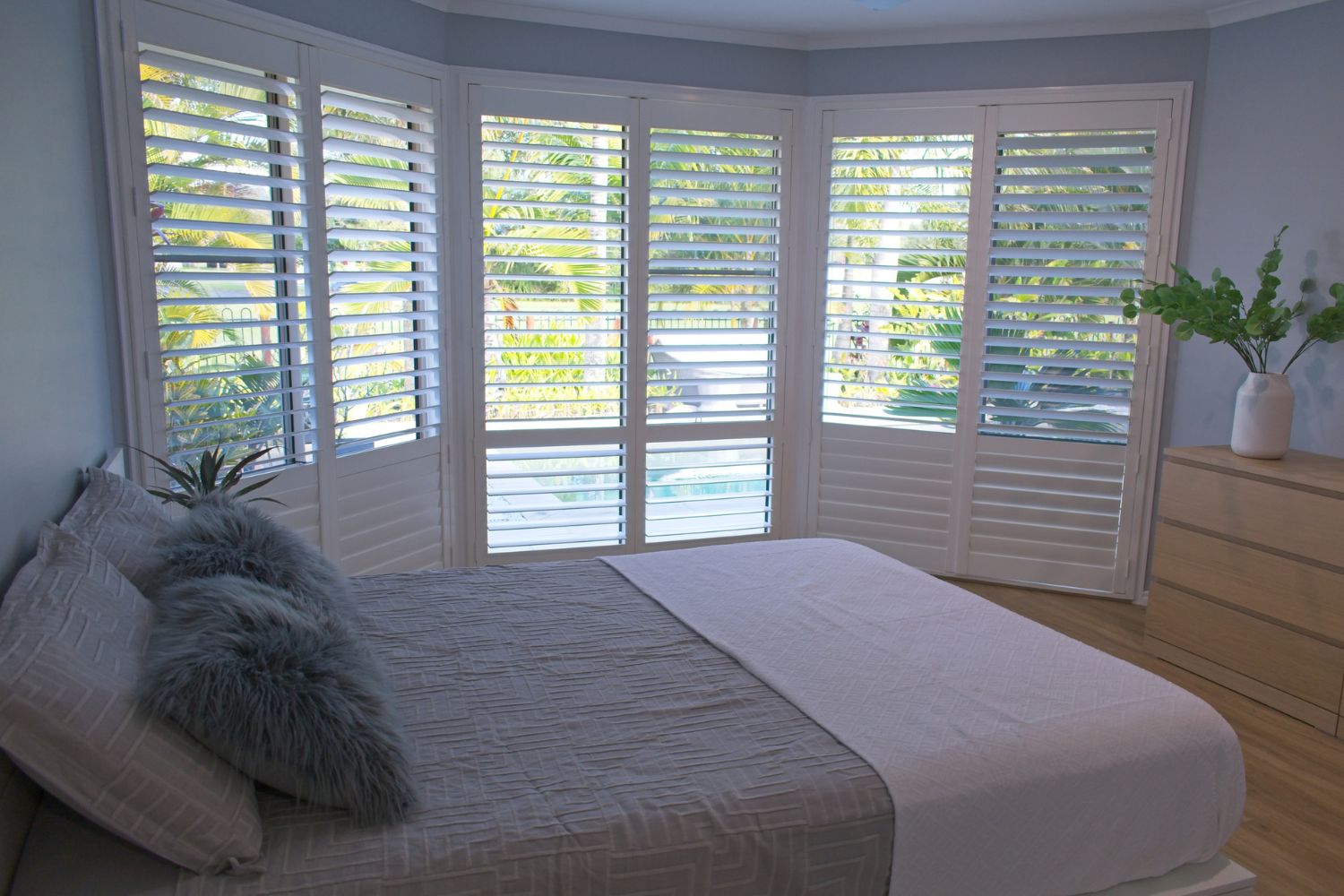
Benefits of Choosing Estate Shutters
Many homeowners consider estate shutters to be classic and traditional window treatments for their home. Estate shutters have many benefits, including energy efficiency, increased privacy, light management, and a good return on investment. Here are some additional benefits of installing estate shutters in the home.
Energy Efficiency
Estate shutters provide additional insulation against cold and hot outside temperatures. They’re designed to control the amount of light and heat allowed into a room, and this can positively impact a home’s heating and cooling bills. By deflecting heat or cold and regulating airflow, estate shutters can help homeowners save money on energy bills throughout the year.
Low Maintenance
Estate shutters are considered low maintenance and are easy to clean with a cloth or vacuum cleaner brush attachment. Because they are fixed to the window, they can be cleaned in place.
Excellent Privacy
Since estate shutters can be completely closed to shut out the outside world, they offer increased privacy for the home. Estate shutters for large windows in the front of a home can allow for excellent privacy when they’re completely closed.
Effective Light Management
Estate shutters have wide louvers that measure between 3½ and 4½ inches wide. When opened, they allow a room to be flooded with light, but when closed, they block heat and light from the outside. When estate shutters are installed correctly with no gaps, homeowners can effectively control the temperature of a room.
High Durability
Although the cost to install traditional blinds may be lower, estate shutters tend to be more durable than other types of blinds and window shades. Pets and children can interact with estate shutters without damage to the shutters or risk of strangulation from loose blind cords.
Hypoallergenic Material
Curtains and fabric shades collect dust, dirt, pet dander, and other allergens. The wide slats on estate shutters make them easy to clean, so those with allergies aren’t exposed to pollen and other allergens in the home. The best window cleaning services can clean estate shutters at the same time they clean the main windows.
Increased Curb Appeal
Estate shutters look good not only on the inside but also on the outside. They complement any type of home decor and, depending on the material, are available in an array of colors and wood stains.
Added Home Value
Installing estate shutters can increase the value of a home, and they provide a decent return on investment (ROI) of 75 percent. Since estate shutters are permanently installed on the inside of the windows, they become part of the home. Many potential home buyers appreciate the appeal of estate shutters when they are looking at houses for sale.
Estate Shutter Installation: DIY vs. Hiring a Professional
If homeowners have experience installing shutters and the required tools, installing estate shutters can be a DIY project. DIY estate shutter installation kits include the shutters and required installation hardware and cost from $290 to $440 per window. Homeowners who do not use a DIY kit will need to buy materials that include hinges, screws, wall anchors, side and end brackets, silicone caulk, and shims. These materials can add up to $50 per window, not including the price of the actual shutters. For those who are inexperienced, measuring the windows incorrectly can result in poorly fitting shutters. Arched or unusually shaped windows can make measuring difficult. A professional can choose the best size estate shutters for each window, ensure the measurements are done correctly, and complete the job in an efficient and timely manner. Inexperienced homeowners may be tempted to learn how to install shutters on their own to save on labor costs, but it’s best to leave the job to the professionals. A reputable window contractor may be able to purchase estate shutters at discounts that are not available to the average homeowner. Paying professional installers can protect the investment of adding estate shutters to the home.
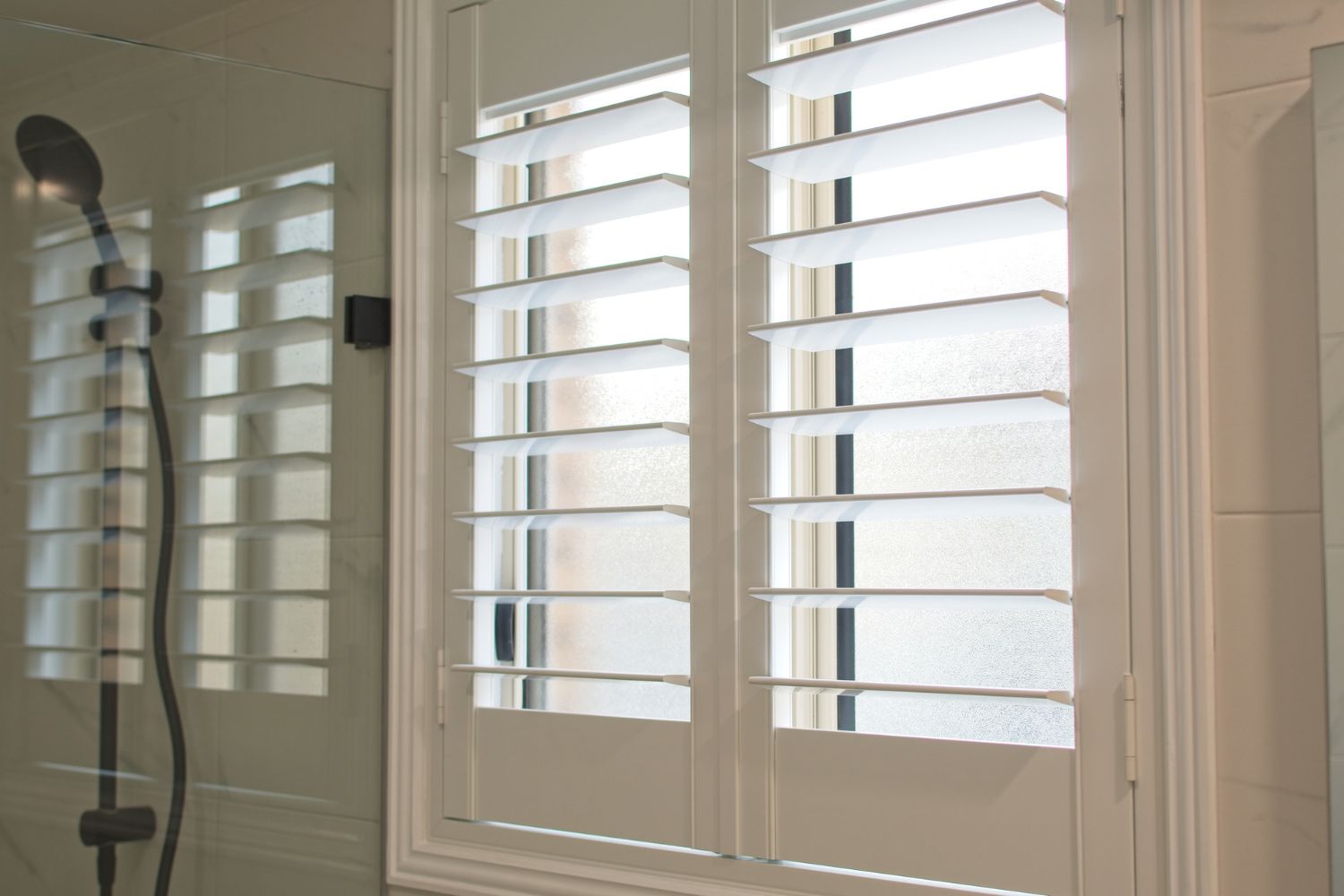
How to Save Money on Estate Shutters Cost
Just as the cost to replace windows in a home is an investment, so is the decision on whether to install estate shutters. Budgeting for estate shutter installation can be daunting, especially when the additional costs and considerations are added to the mix. Deciding on the cheapest shutter option can help homeowners save money, but there are other ways to economize without compromising on quality or style.
- Get multiple quotes. Get at least three quotes from reputable window professionals in your area.
- Choose faux wood. If you really like the look of hardwood estate shutters but aren’t keen on the high price tag, opt for faux wood or vinyl.
- Invest and save. It may seem counterintuitive to spend the money on expensive estate shutters, but they can help you save money on energy bills in the long run.
- Be flexible. Schedule estate shutter installation during the off-season. Window companies typically offer discounts during their slower months in late fall and early winter.
- Order through a window industry professional. To save money on estate shutters, place a bulk order and receive wholesale pricing from a window professional.
Questions to Ask About Estate Shutters Installation
Asking a window professional the right questions about estate shutters can help minimize miscommunication and get the results you want. Below are some questions to ask about estate shutter installation after searching “plantation shutters near me” before deciding on the right professional for the job.
- How long have you been in business?
- Are you licensed?
- Are you insured?
- Will you provide referrals?
- Do you give free estimates?
- Are plantation blinds,plantation shutters, and estate shutters the same thing?
- How long will the installation take?
- Who will install the estate shutters?
- What materials are the estate shutters made of?
- Which shutter material is the best for my home?
- What slat size do you recommend?
- Will you install estate shutters without the vertical tilt bar?
- Do you recommend using a midrail for the estate shutters?
- Can estate shutters be used on sliding windows and doors?
- How will you protect the window and room against damage during installation?
- What is your cleanup policy?
- What warranties do you offer?
- Do you guarantee your installation work?
- How can I leave a review?
FAQs
Before hiring a window contractor to install estate shutters, homeowners should have all the information they need to make an informed decision. What follows are some frequently asked questions regarding estate shutters to help guide your decision-making process.
The following questions use the term “plantation shutters” to reflect the wording of the most common online searches. However, our responses will use the alternate term “estate shutters.”
Q. Do plantation shutters add value?
In short, yes. Plantation, or estate shutters are energy-efficient and low maintenance, and they are a worthwhile addition to any home. Highly desirable estate shutters can add to a home’s appraisal value and boost the interior charm, making the property look more attractive to potential buyers.
Q. What are the disadvantages of plantation shutters?
The most prominent disadvantage of installing estate shutters is the price tag. Estate shutters also don’t work for every type of window, and they need enough furniture clearance to open and close properly. Homeowners should keep in mind as well that estate shutters can sometimes take 6 to 8 weeks to be made and delivered to their home. Because they are attached to the inside of the windows, estate shutters also won’t protect against severe weather, so homeowners may want to consider paying the cost to install hurricane shutters if they live in storm-prone regions.
Q. What are the pros and cons of plantation shutters?
There are many different styles and types of shutters to choose from, so why should a homeowner choose estate shutters? Estate shutters are easy to clean and preferred by those who suffer from allergies. They provide increased privacy, can come in a wide range of colors and wood stains to complement a variety of home designs, are safe for children and pets, offer additional insulation, and add value to a home. On the other hand, estate shutters cannot be removed from the window for cleaning, are more expensive than other window treatments, and are not compatible with all types of windows.
Q. Do plantation shutters make a room look smaller?
Installing estate shutters can enhance the space of the room by leaving the window area neat and tidy. Estate shutters are custom fit to the window and will not cover the trim work or walls like curtains. To create the illusion of a bigger space, homeowners commonly pair white or light-colored estate shutters with light-colored walls. Estate shutters also allow for more control over the amount of light in a room, so the space can look bright and airy.
Q. Do I need curtains with plantation shutters?
Curtains are not needed with estate shutters, and many homeowners opt for estate shutters instead of curtains since the shutters are low maintenance. Curtains can be a hassle to take down to machine-wash, expensive to dry-clean, and prone to fading, tearing, or fraying. On the other hand, curtains can also complement estate shutters, and longer curtains can provide the illusion of a tall window. Some homeowners pair blackout curtains with estate shutters for optimum room darkening.
Q. Where should you not use plantation shutters?
Wood estate shutters are not recommended in areas that experience high levels of moisture, such as kitchens, bathrooms, or basements.
Sources: Angi, HomeAdvisor, HomeGuide

